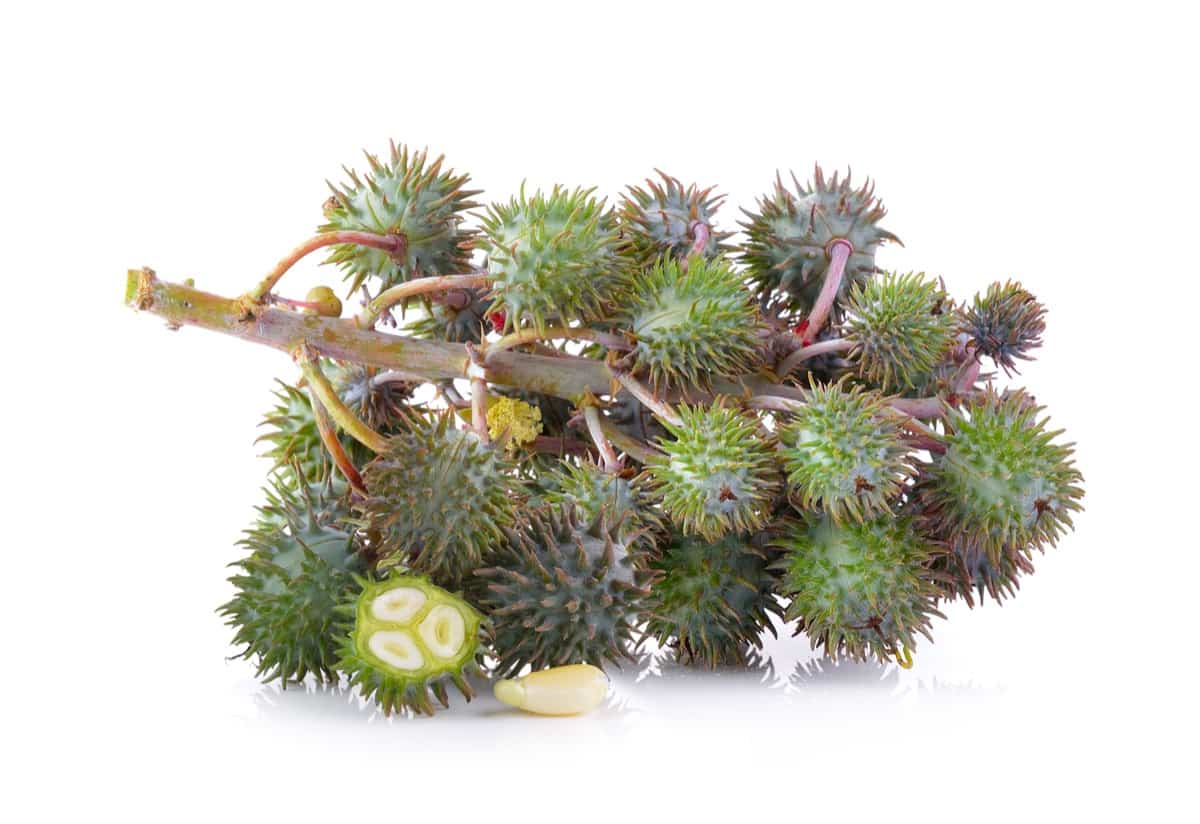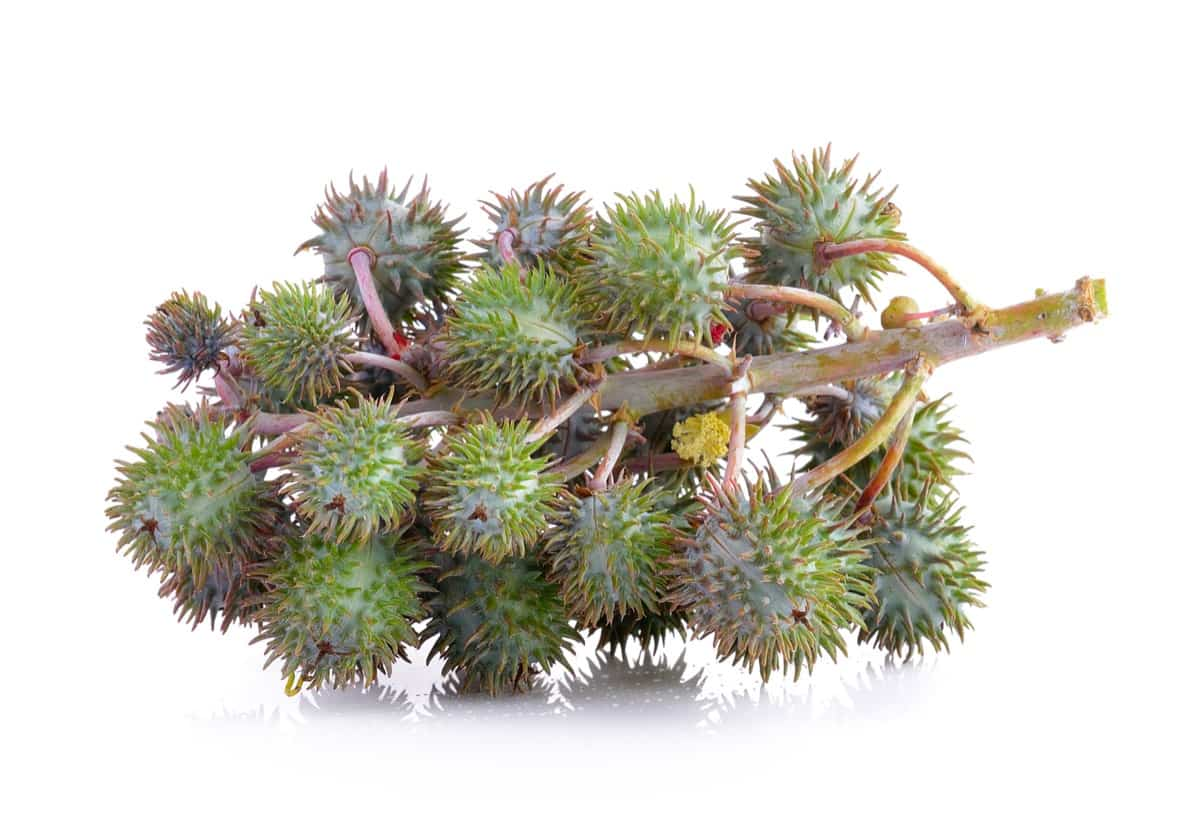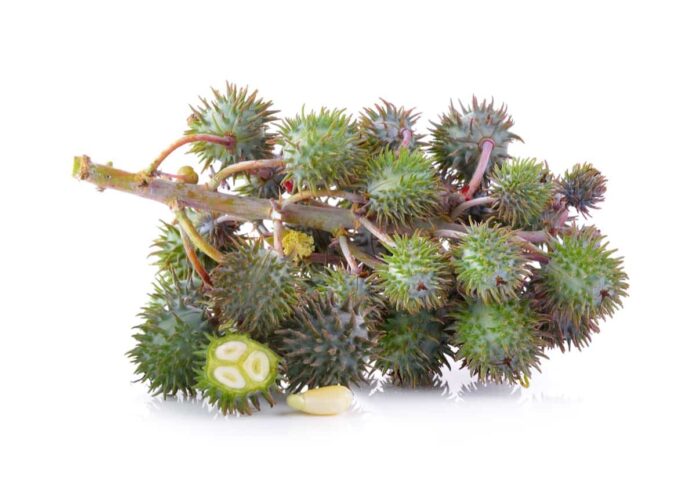Welcome to our journey into the world of high-yielding castor varieties in India. Castor, known for its oil use, has become a significant crop for Indian farmers. In this blog, we’ll explore the secrets behind successful castor cultivation. India has a rich variety of castor hybrids, each with unique advantages. By the end of this blog, you’ll clearly understand which variety suits your needs best. From the new hybrid picks to the traditional varieties, we’ll break down the complexities into digestible nuggets of information.

What is Castor Cultivation?
Castor cultivation is a unique agricultural practice. Castor plants are cross-pollinated and have a distinctive growth pattern. They are protogynous, meaning the female flowers mature before the male ones. Wind pollination is the primary method of fertilization. The castor plant’s inflorescences (flower clusters) grow at the main stem’s and lateral branches’ tips. The main stem ends in a primary raceme, and below it, 2 or 3 branches emerge, each developing secondary racemes.
This pattern continues, with branches beneath secondary racemes producing tertiary racemes.Castor racemes are monoecious, containing pistillate (female) and staminate (male) flowers. These flowers’ proportions vary due to genetics, environment, and nutrition. Winter favors female flowers, while summer and rainy seasons promote male flowers. Additionally, well-nourished young plants display more female flowers than older, poorly-nourished ones.
Boost Your Castor Crop: Top High-Yielding Varieties of Castor in India
Castor Overview: Castor (Ricinus communis L.) is a non-edible oilseed crop from the Euphorbiaceae family. Fifty percent flowering takes 30 to 75 days and 5 to 10 months for remunerative seed yield.
Historical Uses: Castor oil has been used for centuries as medicine, lubricant, hairdressing, and laxative.
Industrial Applications: Recently, castor oil and its derivatives have found use in about 250 industrial products, including hydraulic oil, jet engines, soap, varnish, paint, and nylon thread production.
Global Exports: India exports castor oil and its derivatives, worth 4000-6000 crores, primarily to the U.S.A., European Common Market, and Japan.
Variety Evolution: Over the past five decades, 15 high-yielding varieties and 22 hybrids have been released for cultivation in India, mainly by the AICRP-Castor system.
Hybrid Dominance: More than 95% of India’s total castor cultivated area is under hybrids, thanks to research efforts that led to the development of wilt and leafhopper-resistant hybrids.
Cultivation Statistics: In 2019-20, castor was cultivated on 9.70 lakh hectares with a production of 19.50 lakh tonnes and a productivity of 2010 kg ha-1. Gujarat and Rajasthan account for 92% of the total castor area under irrigated conditions.
Rainfed Cultivation: Around 8% of the castor area is under rainfed conditions, primarily in Telangana, Andhra Pradesh, and Tamil Nadu. Hybrid castor cultivation is also rising in non-traditional areas like Madhya Pradesh, Maharashtra, and Haryana under irrigated conditions.
Latest Varieties and Hybrids: High-yielding hybrids like GCH-8, GCH-9, GNCH-1, YRCH-2, and ICH-66 are currently recommended for cultivation. Notable varieties include 48-1, DCS-107, GC-3, Pragathi, YTP-1, and GAC-11.
In case you missed it: Best Fertilizer for Castor Plants: Organic, Compost, NPK, Management, and Schedule

Getting Started with Castor Farming: Best Hybrid Picks
Hybrid Selection Choosing the right hybrid is crucial for successful castor farming. Different hybrids are recommended for various regions based on their adaptability and yield potential.
GAUCH-1 (1976)
- Suitable for irrigated areas of Gujarat and rainfed areas in southern India.
- An early maturing hybrid with a drought escape mechanism.
GCH-2 (1986)
- Ideal for irrigated areas of Gujarat.
- Tolerant to root rot, making it a robust choice.
GCH-4 (1988)
- Suited for both rainfed and irrigated areas.
- Resistant to leafhoppers and tolerant to Fusarium wilt.
GCH-5 (1997)
- Recommended for rainfed and irrigated areas in Gujarat.
- It features red, double blooms, medium duration, and tolerance to wilt.
GCH-6 (1999)
- Well-suited for rainfed and irrigated late kharif regions in Gujarat, Rajasthan, and Maharashtra.
- It is red, single bloom, spiny, and tolerant to Macrophomina root rot.
DCH-177 (2000)
- Ideal for rainfed areas in Andhra Pradesh, Karnataka, Tamil Nadu, and Maharashtra.
- It is red, single bloom, spiny, and early maturing, resistant to Fusarium wilt.
RHC-1 (2000)
- Suitable for rainfed and irrigated areas of Rajasthan.
- It is known for its mahogany color, triple bloom, spiny nature, and leafhopper resistance.
In case you missed it: Cooperative Societies in the Agricultural Sector in India: Benefits, Role, and Challenges

DCH-519 (2006)
- Recommended for both rainfed and irrigated regions.
- Features green, triple blooms, spiny characteristics, and resistance to Fusarium wilt and leafhopper.
GCH-7 (2006)
- Suited for irrigated areas in Gujarat.
- Resistant to nematode-wilt complex, ensuring a healthy crop.
YRCH-1 (2009)
- Recommended for rainfed and irrigated areas of Tamil Nadu.
- Exhibits moderate resistance to capsule borers.
PCH-111 (2012)
- Ideal for rainfed and irrigated areas in Andhra Pradesh and Telangana.
- Resistant to Fusarium wilt and moderately tolerant to various pests.
GCH-8 (2018)
- Suitable for both rainfed and irrigated regions.
- Mahogany in color with triple blooms, semi-spiny, and resistant to Fusarium wilt and leafhoppers.
GCH-9 (2018)
- Recommended for Gujarat.
- Red, triple bloom, and resistant to Fusarium wilt and Macrophomina root rot.
GNCH-1 (2017)
- Suited for Gujarat.
- Features red, triple blooms, semi-spiny traits, and resistance to Fusarium wilt and leafhopper.
YRCH-2 (2018)
- Suitable for rainfed and irrigated areas.
- Exhibits red, triple blooms, semi-spiny characteristics, and resistance to Fusarium wilt and leafhopper.
ICH-66 (2019)
- Recommended for rainfed regions in A.P., Telangana, Karnataka, Tamil Nadu, and Odisha.
- Displays red, triple blooms, semi-spiny features, and resistance to Fusarium wilt, Macrophomina root rot, and leafhopper.
G.C.H. (2020)
- Ideal for Gujarat.
- Features red, triple blooms, spiny characteristics, and resistance to Fusarium wilt and leafhopper.
Castor Cultivation Made Easy: Choosing the Right Variety
48-1 (Jwala) – 2007
- Parentage: High Oil Mutant x Mauthner’s Dwarf.
- Average Yield: 1100 kg ha-1.
- Areas Recommended: All castor-growing regions of India.
- Salient Features: Resistant to Fusarium wilt, tolerant to Botrytis, saline, and drought conditions.
- Source of Seed: ICAR-Indian Institute of Oilseeds Research, Hyderabad, Telangana-500030.
In case you missed it: 17 Gardening Mistakes to Avoid This Summer: For Vegetables, Flowers, Herbs, and Fruits

DCS-107 – 2011
- Parentage: DCH-177 x JI-133.
- Average Yield: 1200-1430 kg ha-1.
- Areas Recommended: All castor-growing regions of India.
- Salient Features: Resistant to Fusarium wilt.
- Source of Seed: ICAR-Indian Institute of Oilseeds Research, Hyderabad, Telangana-500030.
GC-3 – 2012
- Parentage: (JP-65 x JI-88) x 48-1.
- Average Yield: 1500 kg ha-1.
- Areas Recommended: Irrigated conditions of Gujarat.
- Salient Features: Resistant to Fusarium wilt and tolerant to Macrophomina root rot.
- Seed source: Main Oilseeds Research Station, J.A.U., Junagadh, Gujarat-362015.
Pragathi – 2015
- Parentage: M-574 x PCS-124.
- Average Yield: 1500-1800 kg ha-1.
- Areas Recommended: Rainfed conditions of Telangana.
- Salient Features: Resistant to Fusarium wilt.
- Source of Seed: Regional Agricultural Research Station (RARS), PJTSAU, Palem, Telangana-509381.
YTP-1 (YRCS-1205) – 2019
- Parentage: TMV-6 x Salem Local.
- Average Yield: 1450 as an annual crop (7 months), 3110/year as perennial (12 months).
- Areas Recommended: Rainfed and irrigated perennial ecosystem of Tamil Nadu.
- Salient Features: Non-lodging, non-shattering, suitable both as annual and perennial, intercropping system perennial.
- Source of Seed: Tapioca and Castor Research Station, Tamil Nadu Agricultural University, Yethapur, Salem District, Tamil Nadu-636 119.
GAC-11 – 2019
- Parentage: Selection from the base population of ANDCI-8.
- Average Yield: 2360 kg ha-1.
- Areas Recommended: Irrigated & rainfed middle Gujarat, kharif season.
- Salient Features: Resistant to Fusarium wilt.
- Source of Seed: Agricultural Research Station, Anand Agricultural University, Sansoli, Gujarat-387130.
Maximizing Castor Yields: A Guide to Indian Varieties
Historical Development
- In the U.S.A., developing N type pistillate line, N 145-4, in the 1950s paved the way for harnessing hybrid vigor.
- A 100% pistillate line, T.S.P. 10 R, was introduced in 1962 in the U.S.A.
- Another stable pistillate line, N.E.S. 1, based on environmentally sensitive staminate flower characteristics and a recessive sex-switching gene, was released in Davis, California, 1964 and is still in use.
Hybrid Cultivation in India
- Gujarat initiated hybrid seed production in the mid-1960s.
- The first hybrid released in India was GCH3 (Gujarat Castor Hybrid) in 1968, derived from the cross T.S.P. 10 R x J.I. 15.
- Indigenous pistillate line V.P. 1 led to the release of GAUCH 1 in 1973, although it is susceptible to wilt and root rot diseases.
- Subsequently, G.C.H. 2 was released in 1985, and G.C.H. 4 in 1986, both still cultivated.
Hybrids and Their Parentage
- GCH 3: TSP 10 R x JI 15
- GAUCH 1: V.P. 1 x V 19
- G.C.H. 2: V.P. 1 x J.I. 35
- GCH 4: VP 1 x 48-1
- TMVCH 1: LRES 17 x TMV 5
Land Requirements
- Choose well-drained, fertile soil. Castor cannot tolerate alkalinity and salinity.
- Medium to deep sandy loam and heavy loam soils are highly suitable for castor seed production.
Isolation Distance
- Foundation Seed: 600 meters
- Certified Seed: 300 meters
In case you missed it: Bahar Treatment in Pomegranate for High Quality and Yields: A Step-by-Step Guide to Implementation

Seasonal Considerations
- Rabi/Winter is ideal for hybrid seed production.
- Summer and kharif provide favorable conditions for seed production of both male and female parents of hybrids.
- Kharif and summer encourage the expression of less productive plants, which can be easily removed through timely roguing.
- Female parents raised in male-promoting environments produce environmentally sensitive staminate flowers, which is crucial for the self-production of female parents.
Seed and Sowing
- Seed Rate for Varieties: 10 kg/ha
- Seed Rate for Hybrids: 2 kg/ha male, 5 kg/ha female
Spacing
- Varieties: 90 x 20 to 90 x 60 cm
- Hybrids: 90 x 40 to 90 x 60 cm
Planting Ratio
- Varieties: 3:1
- Hybrids: 4-6:1
The Secret to Bumper Castor Harvests: Hybrid Varieties
Bumper castor harvests are achieved through the strategic utilization of hybrid varieties. These hybrids, developed through controlled breeding, combine the desirable traits of different parent lines, enhancing castor crop productivity. They exhibit resistance to diseases like Fusarium wilt and environmental adaptability.
Additionally, hybrids allow for the exploitation of hybrid vigor, resulting in increased yields. By selecting and cultivating the right hybrid varieties based on specific regional conditions, farmers can unlock the secret to achieving abundant castor harvests, maximizing their agricultural output.
From Seed to Success: High-Yielding Castor Varieties
These varieties have been developed through rigorous breeding programs, emphasizing increased oil content, disease resistance, and adaptability to diverse environmental conditions. Scientifically, they are selected for their genetic makeup, which enhances productivity. By selecting the right high-yielding castor varieties and adhering to precise agricultural practices, farmers can optimize their crop’s potential.
Exploring Castor Variety Benefits: Top Hybrid Choices
GCH 3 (Gujarat Castor Hybrid 3)
- Yield Potential: Derived from TSP 10 R x JI 15, this hybrid offers excellent yields.
- Adaptability: Well-suited for both rainfed and irrigated conditions.
- Disease Resistance: Resistant to Fusarium wilt, a common castor disease.
GAUCH 1 (Gujarat Castor Hybrid 1)
- Parentage: VP 1 x V 19.
- Yield Quality: Known for its high yield potential.
- Regional Suitability: Thrives in the diverse climatic conditions of Gujarat.
GCH 2 (Gujarat Castor Hybrid 2)
- Parentage: VP 1 x JI 35.
- Robust Performance: Tolerant to root rot, ensuring crop stability.
- Ideal for Gujarat’s Irrigated Areas.
GCH 4 (Gujarat Castor Hybrid 4)
- Parentage: VP 1 x 48-1.
- Disease Resistance: Resistant to leafhoppers and tolerant to Fusarium wilt.
- Well-established Hybrid Choice.
In case you missed it: Management of Cutworms in Chilli: Prevention and Control With Organic, Chemical, Cultural Practices

TMVCH 1 (TMV Castor Hybrid 1)
- Parentage: LRES 17 x TMV 5.
- Yield Potential: Offers competitive yields in suitable regions.
- Disease Resilience: Resistant to Fusarium wilt and other common castor diseases.
Conclusion
India’s pursuit of high-yielding castor hybrids and varieties has significantly bolstered the country’s castor cultivation industry. Through diligent breeding and research, these cultivars offer farmers the promise of increased yields, disease resistance, and adaptability to varied climates, ensuring a bright future for castor farming in India.
- Varieties of Castor in India: Boost the Profit with High-yielding Hybrids of Castor
- Cooperative Societies in the Agricultural Sector in India: Benefits, Role, and Challenges
- 17 Gardening Mistakes to Avoid This Summer: For Vegetables, Flowers, Herbs, and Fruits
- Bahar Treatment in Pomegranate for High Quality and Yields: A Step-by-Step Guide to Implementation
- Mobile Veterinary Units in India: Implementation in States
- Moringa as Feed for Livestock: Moringa Fodder Crop Yield Per Acre
- National Beekeeping and Honey Mission (NBHM): Features, Schemes, and Benefits
- Management of Cutworms in Chilli: Prevention and Control With Organic, Chemical, Cultural Practices
- Best Fertilizer for Tinda: Organic, Natural, Homemade, NPK Ratio, When and How to Apply
- Whitefly Management in Cotton Crop: Symptoms, Control, and Best Insecticides for Cotton
- Best Fertilizer for Terrace Plants: Covering Vegetables, Fruits, Flowers, and Herbs
- 12 Best Compost Bins for Home in India with Price: Cheap for Indoors, Outdoors, and Kitchens
- Grapes Training Systems and Methods: A Comparative Analysis
- Best Fertilizer Jamun Tree: Organic, Natural, Homemade, Npk Ratio, When and How to Apply
- Polyhalite Fertilizers and their Role in Organic Farming
- How to Identify Fake Seeds: Key Differences Between Real and Counterfeit Seeds
- Best Fertilizer for Indian Gooseberry/Amla: Organic, Homemade, NPK Ratio, When and How to Apply
- Best Fertilizer for Bitter Gourd: Organic, Natural, Homemade, NPK Ratio, When and How to Apply
- Bangalore Method of Composting: Preparation Method, Benefits, and Disadvantages
- How to Check PM Kisan Status: Beneficiary Verification With Aadhaar Number and Mobile
- 15 Best Chaff Cutter Machines in India: For Dry, Green Fodder Cutting, and Price List Included
- Bermuda Grass Fertilizer Schedule: When and How to Apply in Winter, Summer, and Spring
- 20 Best Plants to Grow Under Oak Trees: Compatible Plants Under and Around Oaks
- Benefits of DAP Fertilizer: Price, Composition, How and When to Apply
- Profitable Thai Guava Farming in India: Yield, Profit Per Acre, Plant Price, 1 Acre Cost of Cultivation
- Top 19 Water Harvesting Techniques: What is Water Harvesting and Benefits of It
- Best 20 Lemon Varieties: Sweet, Large, and Rare High Yield Cultivars
- Top 15 Agro Based Industries in India: Best List for Agri Entrepreneurs
- Career Opportunities in Agribusiness Management: Top 10 Jobs After Agribusiness Management
- Top 20 Pumpkin Varieties to Grow in Your Garden: Best List of Pumpkin Varieties for High Profits
- How to Grow Cordyceps Mushrooms: Profitable Cultivation Practices and Cordyceps Mushroom Price
- Top 20 Lettuce Varieties to Grow in Your Garden: Best List for Backyard for Fall and Winter
- Top 20 Grape Varieties to Grow in India: List of Grape Varieties to Grow for High Profits
- Best Fruit Nurseries in Tamil Nadu: Top List of Saplings Supplier for High Yield and Profits
- Top 20 Apple Varieties in India: List of Apple Varieties to Grow for High Profits
- Advantages of Vegetative Propagation and Disadvantages of Vegetative Propagation: Examples
